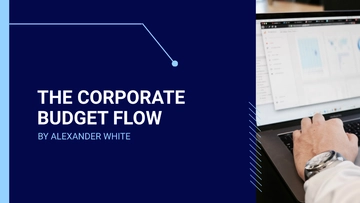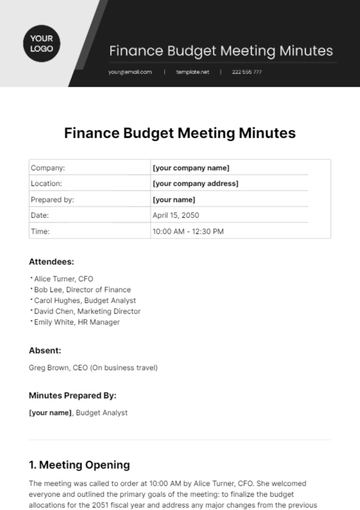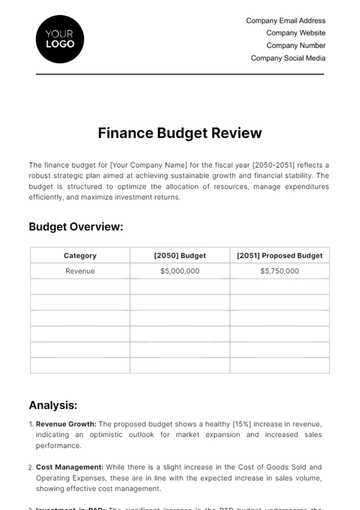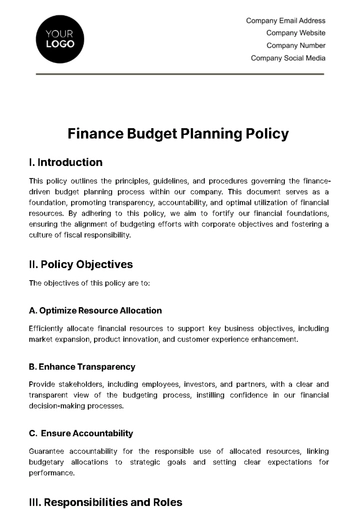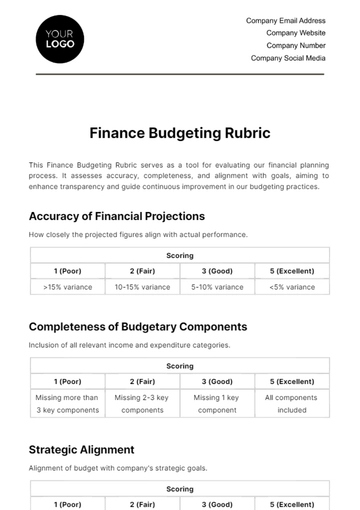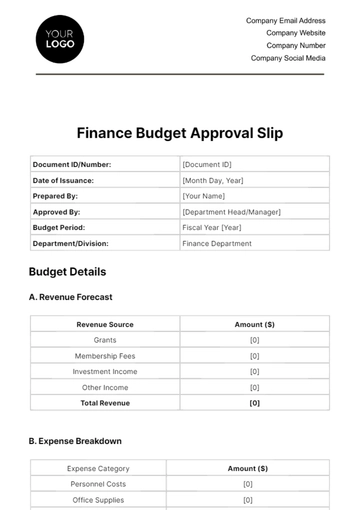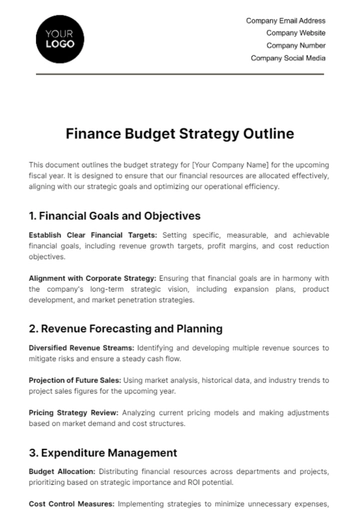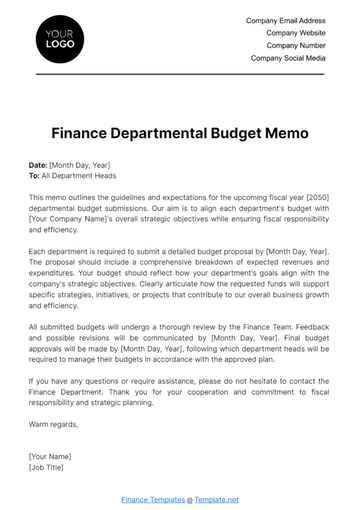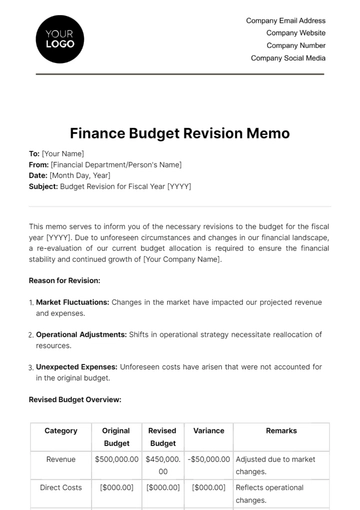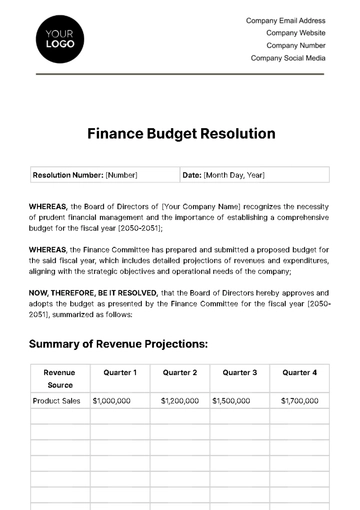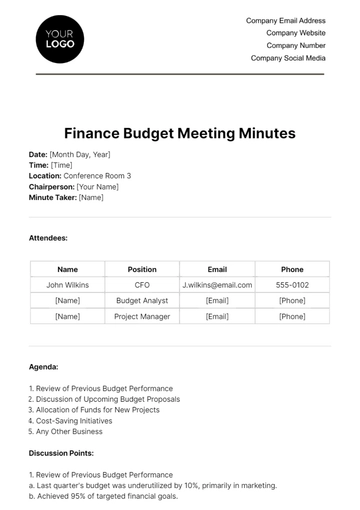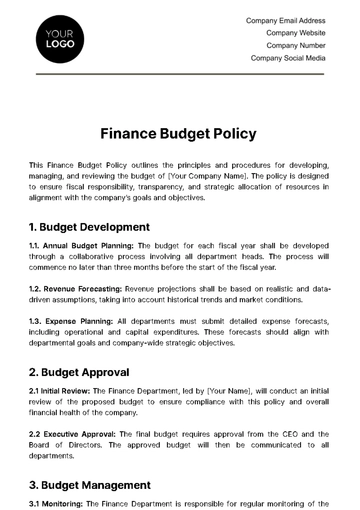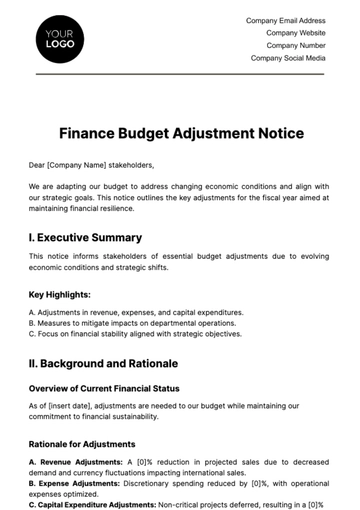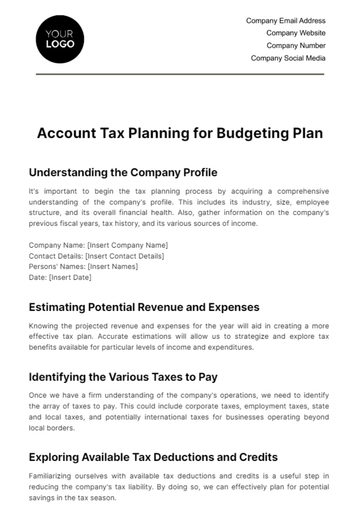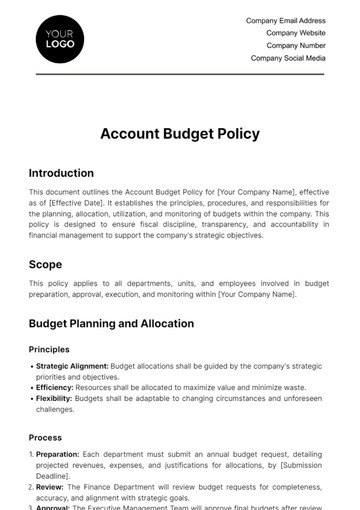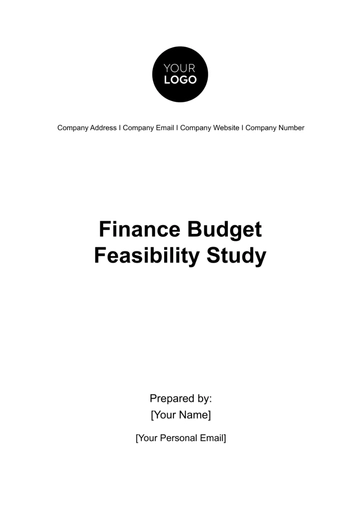Free Long-Term Finance Budget Planning
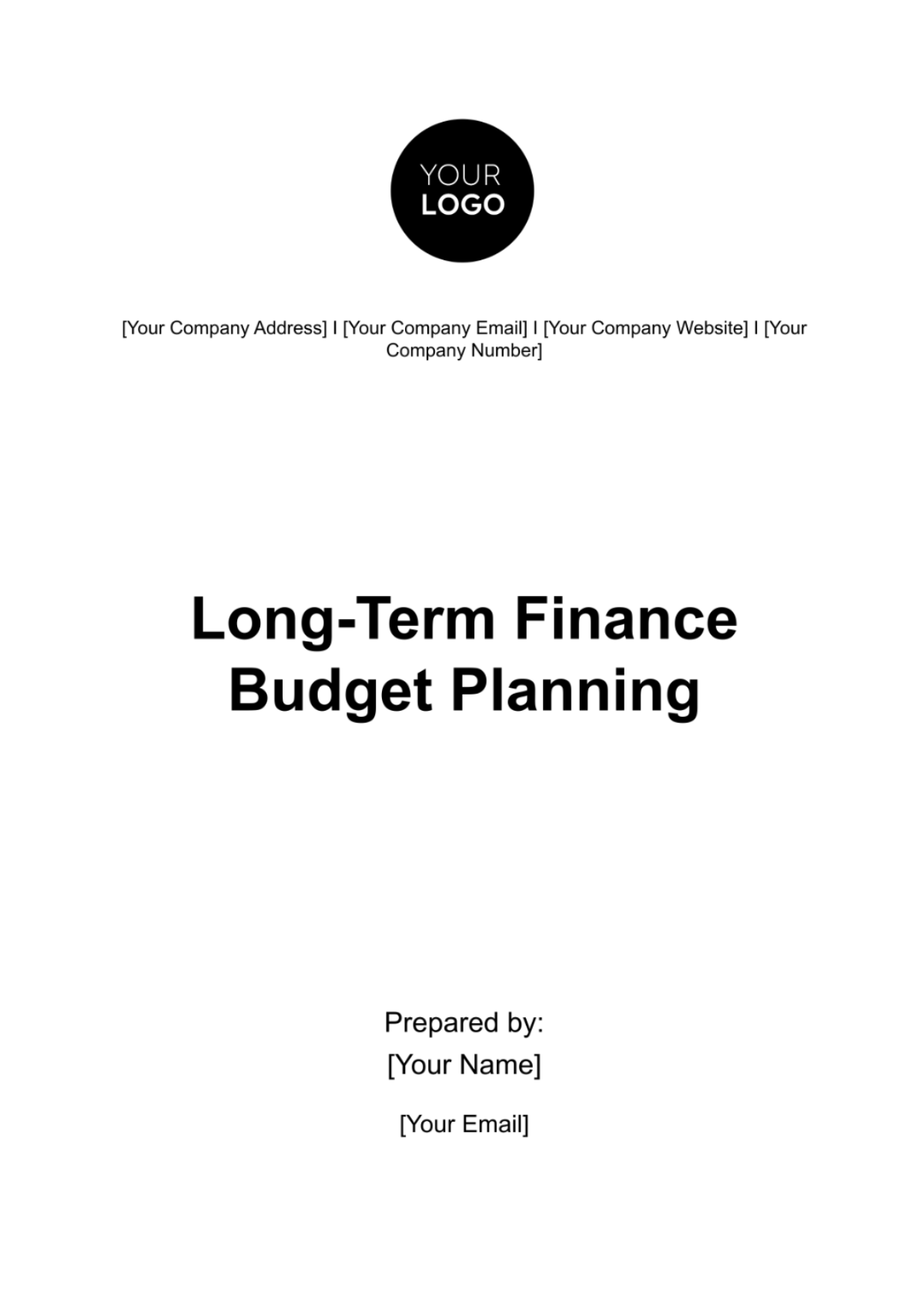
I. Executive Summary
In this comprehensive Long-Term Finance Budget Planning, [Your Company Name] positions itself for sustained success by meticulously aligning financial strategies with overarching business goals. Over the next five years, our core objectives involve not only expanding market share but also fostering innovation and maintaining financial resilience. This plan serves as a strategic roadmap, ensuring prudent resource allocation, risk mitigation, and adaptability in a dynamic business landscape. Emphasizing financial sustainability, the executive summary highlights our commitment to achieving long-term growth while remaining agile in response to evolving market conditions.
II. Strategic Context
Our budget is intricately woven into the strategic fabric of [Your Company Name], considering not only internal capabilities but also external market dynamics. Market trends, competitor analysis, and emerging opportunities guide our strategic priorities, which include enhancing product offerings, optimizing operational efficiency, and embracing cutting-edge technology. By contextualizing our financial strategy within the broader industry landscape, [Your Company Name] aims to capitalize on market trends, mitigate risks, and emerge as a resilient player in the years to come.
III. Financial Goals and Objectives
Revenue Growth
Our primary financial goal is to achieve a robust 10% year-over-year increase in total revenue. To attain this, we will focus on diversifying our product portfolio, entering new markets, and leveraging strategic partnerships. By aligning revenue growth with market demand and customer needs, we aim to secure a competitive position and enhance the overall financial health of [Your Company Name].
Cost Efficiency
Initiatives to drive cost efficiency are pivotal to our long-term financial strategy. We plan to implement a series of measures, including process optimization, supply chain enhancements, and strategic vendor partnerships, to achieve a targeted annual reduction of 5% in operating costs. This commitment to cost efficiency ensures that our growth is not only sustainable but also accompanied by improved operational effectiveness.
Profitability
Maintaining a minimum 15% profit margin is a core objective that underscores our commitment to financial sustainability. This involves a balanced approach to revenue growth and cost management. By continuously monitoring and optimizing profit margins, we aim to build a resilient financial foundation that supports our strategic initiatives and withstands economic fluctuations.
IV. Revenue Projections
Revenue Forecast (in millions)
Our revenue projections outline a trajectory of steady growth, meticulously crafted to align with our strategic objectives. By investing in the development of Product A and expanding our market reach with Product B, we anticipate a total revenue of $[0] million by [Year]. These projections are grounded in market research, customer demand analysis, and a keen understanding of our competitive landscape. The detailed breakdown per product provides transparency, aiding strategic decision-making and resource allocation.
Year | [Product A] | [Product B] | Total Revenue |
[Year] | $[0] | $[0] | $[0] |
[Year] | $[0] | $[0] | $[0] |
[Year] | $[0] | $[0] | $[0] |
[Year] | $[0] | $[0] | $[0] |
[Year] | $[0] | $[0] | $[0] |
[Year] | $[0] | $[0] | $[0] |
V. Cost Projections
Operating Costs (in millions)
To support our ambitious revenue targets, we anticipate a gradual rise in operating costs. However, stringent cost management practices will ensure that the total costs remain at $[0] million by [Year]. This delicate balance between revenue growth and cost containment is critical to sustaining healthy profit margins and maintaining financial resilience.
Year | Personnel Costs | Operating Expenses | Total Costs |
[Year] | $[0] | $[0] | $[0] |
[Year] | $[0] | $[0] | $[0] |
[Year] | $[0] | $[0] | $[0] |
[Year] | $[0] | $[0] | $[0] |
[Year] | $[0] | $[0] | $[0] |
VI. Capital Expenditure Plan
Major Investments (in millions)
Strategic investments are earmarked to propel our growth and innovation initiatives. The $[0] million facility expansion in [Year] will increase production capacity, ensuring we meet growing demand. Simultaneously, a $[0] million infusion for market expansion in [Year] will facilitate entry into new territories. Funding sources are carefully selected, ranging from internal funds for routine upgrades to a mix of debt and equity for transformative projects.
Year | Capital Expenditure Category | Investment Amount | Funding Source |
[Year] | IT Infrastructure | $[0] | Internal Funds |
[Year] | Facility Expansion | $[0] | Debt Financing |
[Year] | R&D and Innovation | $[0] | Equity Financing] |
[Year] | Machinery Upgrade | $[0] | Internal Funds |
[Year] | Market Expansion | $[0] | Equity and Debt Mix |
VII. Funding Strategy
Funding Mix (in millions)
Our funding strategy is characterized by a judicious mix of equity financing, debt financing, and internal funds. By [Year], we anticipate a harmonized funding mix totaling $[0] million. This approach ensures financial stability, minimizes dependency on a single source, and aligns with our commitment to sustainable financial practices.
Year | Equity Financing | Debt Financing | Internal Funds |
[Year] | $[0] | $[0] | $[0] |
[Year] | $[0] | $[0] | $[0] |
[Year] | $[0] | $[0] | $[0] |
[Year] | $[0] | $[0] | $[0] |
[Year] | $[0] | $[0] | $[0] |
VIII. Financial Risk Management
Identifying and proactively managing financial risks are critical components of [Your Company Name]'s long-term strategy. Our comprehensive approach to financial risk management encompasses a thorough understanding of potential challenges, including interest rate fluctuations, currency risks, and market uncertainties. Regular market assessments will enable us to stay ahead of dynamic economic conditions, allowing for agile responses to emerging risks. By maintaining a diversified funding portfolio, we aim to mitigate the impact of fluctuations in interest rates and currency values. Additionally, a robust risk management framework has been established to evaluate, monitor, and address potential risks promptly, ensuring that our financial resilience remains a cornerstone of our overall strategy. This commitment to financial risk management underscores our dedication to maintaining stability and safeguarding the financial health of [Your Company Name] over the long term.
IX. Key Performance Indicators (KPIs)
Performance Metrics
Our key performance indicators (KPIs) are rooted in realistic targets essential for measuring success. With a targeted [0]% revenue growth rate by [Year] and a steady return on investment (ROI), we aim to demonstrate sustained financial health. These metrics will serve as benchmarks for our ongoing performance evaluations.
KPI | Target ([Year]) | Target ([Year]) | Target ([Year]) | Target ([Year]) | Target ([Year]) |
Revenue Growth Rate | [0]% | [0]% | [0]% | [0]% | [0]% |
Return on Investment (ROI) | [0]% | [0]% | [0]% | [0]% | [0]% |
X. Monitoring and Review
Our commitment to budget effectiveness is reinforced through rigorous monitoring and regular reviews. Quarterly assessments will provide a detailed analysis of our financial performance, enabling us to identify deviations promptly. This proactive approach ensures that our budget remains dynamic, responsive to changing market conditions, and aligned with our long-term objectives. The insights gained from these reviews will inform strategic decisions, allowing us to adapt and optimize resource allocation strategies in real-time.
XI. Assumptions and Sensitivity Analysis
While our budget is built on well-informed assumptions, we recognize the need to prepare for unforeseen changes. Our comprehensive sensitivity analysis involves systematically evaluating the potential impact of varying assumptions on our financial projections. This proactive measure not only enhances our risk preparedness but also equips [Your Company Name] with the flexibility to adjust strategies swiftly in response to changing economic conditions, reinforcing our commitment to adaptive financial management.
X. Conclusion
This Long-Term Finance Budget Planning lays the groundwork for [Your Company Name]'s financial success. By meticulously addressing revenue projections, cost management, capital expenditures, funding strategies, and risk mitigation, we've created a comprehensive roadmap for sustainable growth. With a focus on continuous monitoring, proactive risk management, and adaptability to changing assumptions, we are poised to navigate the complexities of the business landscape and achieve our long-term financial objectives. [Your Company Name] remains committed to a resilient and dynamic financial future.
- 100% Customizable, free editor
- Access 1 Million+ Templates, photo’s & graphics
- Download or share as a template
- Click and replace photos, graphics, text, backgrounds
- Resize, crop, AI write & more
- Access advanced editor
Explore financial foresight with the Long-Term Finance Budget Planning Template from Template.net. This editable and customizable tool, equipped with an intuitive AI Editor, empowers strategic thinkers. Align your organization's goals seamlessly, manage risks, and optimize resources effortlessly. Elevate financial stability with this user-friendly template, ensuring a resilient roadmap for long-term success.
You may also like
- Budget Sheet
- Personal Budget
- Non Profit Budget
- Monthly Budget
- Project Budget
- HR Budget
- Company Budget
- Home Budget
- Weekly Budget
- College Budget
- Business Budget
- Construction Budget
- Small Business Budget
- Hotel Budget
- Annual Budget
- Home Renovation Budget
- Household Budget
- Student Budget
- Grocery Budget
- Marketing Budget
- Corporate Budget
- Startup Budget
- Manufacturing Budget
- Church Budget
- University Budget
- Annual Budget Plan
- Event Budget
- Operating Budget
- Travel Budget
- Food Budget
- IT and Software Budget
- School Budget
- Real Estate Budget
- Sales Budget
- Conference Budget
- Budget Finance
- Freelancer Budget
- Budget Advertising
